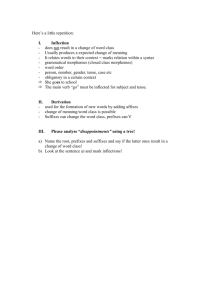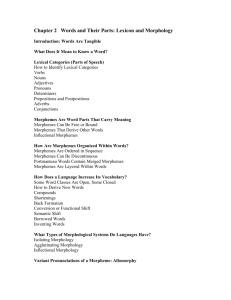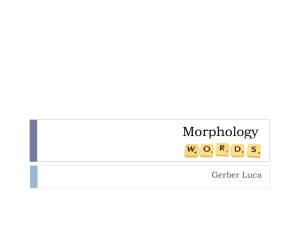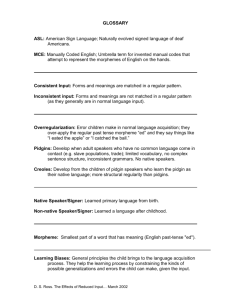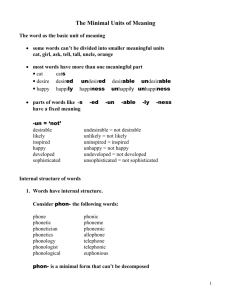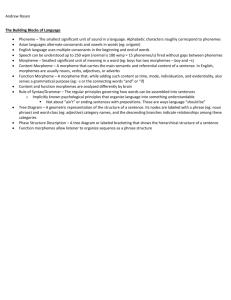Morphology notes
advertisement
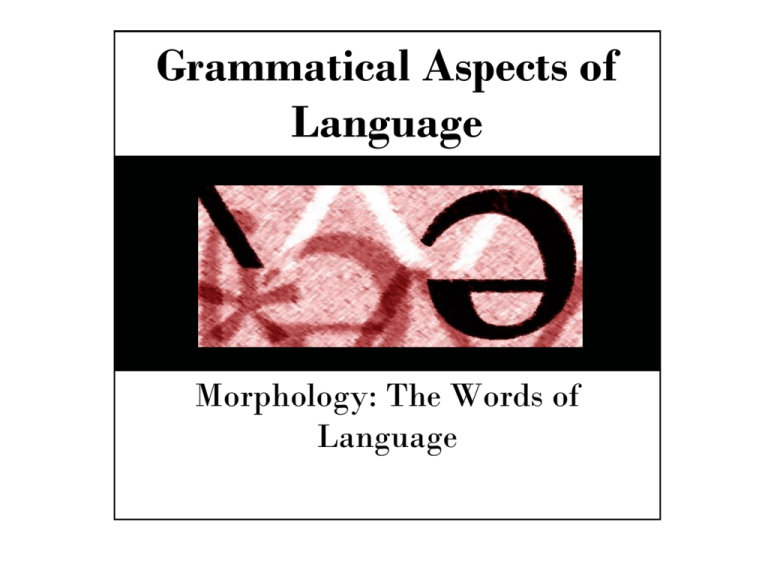
Grammatical Aspects of Language Morphology: The Words of Language The Wug Experiment The Wug Experiment The Wug Experiment The Wug Experiment The Wug Experiment Morphology (This is a really famous experiment, by the way!) The Wug Test • Footage of a child taking the wug test • Jean Berko Gleason (the inventor of the wug test) administers the test to an adult Morphology • The study of the structure of words • The rules of word formation • How do we store all these words in our brains? Morphology • How do we know when one word stops and the other starts? • Lexicon: an individual’s mental dictionary Your mental lexicon • Take the word play. In your notebook, write down the following: – – – – How you’d pronounce it (phonetically) As many definitions as you can think of The spelling Use it in two sentences, using it slightly differently each time. Your mental lexicon • The brain catalogues: – Pronunciation – Meaning – Related words (synonyms, antonyms, close semantic relationships) – Spelling – Alternate pronunciations or spellings – Grammatical category (noun, verb, etc.) Content Words and Function Words • Content words • Function words Content Words and Function Words • Count the number of Fs in this sentence: FINISHED FILES ARE THE RESULT OF YEARS OF SCIENTIFIC STUDY COMBINED WITH THE EXPERIENCE OF YEARS. Write down the number; don’t say it out loud. Content Words and Function Words • There are six (most people only count three) • Most people skip over at least one function word FINISHED FILES ARE THE RESULT OF YEARS OF SCIENTIFIC STUDY COMBINED WITH THE EXPERIENCE OF YEARS. Morphemes: The Minimal Units of Meaning “They gave it to me,” Humpty Dumpty continued, “for an un-birthday present.” “I beg your pardon?” Alice said with a puzzled air. “I’m not offended,” said Humpty Dumpty. “I mean, what is an un-birthday present?” “A present given when it isn’t your birthday, of course.” --Lewis Carroll, Through the Looking Glass Inflection • An inflected language: changes words slightly to change meaning. • English depends on inflection and syntax Inflection vs. Sytax: Latin vs. English In English, word order changes the meaning: The boy gives the girl a rose. The girl gives the boy a rose. Inflection vs. Syntax Latin vs. English In Latin, words can be in any order. The inflection (the way the word changes) changes the meaning. Puer / Pueri / Puero / Puerum = boy Puella / Puellae / Puellam = girl Rosa / Rosae / Rosam / Rosarum = rose Puer puellae rosam dat = The boy gives the girl a rose Puellae rosam puer dat = The boy gives the girl a rose Puellae puer rosam dat = The boy gives the girl a rose Rosam dat puer puellae = The boy gives the girl a rose Morphemes: The Minimal Units of Meaning • Morpheme: a basic unit of meaning that can’t be broken down into a smaller unit of meaning. • Can be a root, prefix, or suffix • Morphology: The study of how words can be put together. Morphemes: The Minimal Units of Meaning • If a singer sings and a flinger flings, why doesn’t a finger fing? – Singer is two morphemes (sing + er) – Finger is only one morpheme (it can’t be broken down into any more morphemes) • All languages are discrete Morphemes: The Minimal Units of Meaning • Free morphemes • Bound morphemes Morphemes in other languages • Different languages attach morphemes differently • Isthmus Zapotec (a native Mexican language) – Attaches prefix ka- to make a word plural zigi (chin) zike (shoulder) diaga (ear) kazigi (chins) kazike (shoulders) kadiaga (ears) Morphemes in other languages • In English, we don’t change anything (about the word) to change a verb to a noun. – I like to dance vs. There’s a dance on Friday • Turkish – add suffix –ak to change a verb to a noun Dur (to stop) Bat (to sink) durak (stopping place) batak (sinking place / marsh or swamp) Morphemes in other languages • In English, we express reciprocal action by saying each other (love each other, understand each other) • Turkish – Adds –ish (after a consonant) or –sh (after a vowel) to express reciprocal action Anla (understand) Sev (love) anlash (understand each other) sevish (love each other) Morphemes in other languages • Some languages have infixes, or morphemes inserted into other morphemes • Bontoc (Philippines) Fikas (strong) Kilad (red) Fusul (enemy) fumikas (to be strong) kumilad (to be red) fumusul (to be an enemy) Does English have infixes? Morphemes in Other Languages • Circumfixes: morphemes that are attached to a base morpheme at the beginning and end. • Chickasaw (Native language of OK) – A word is made negative by adding ik- to the beginning, dropping the final vowel, and adding an –o Chokma (he is good) Lakna (it is yellow) Palli (it is hot) Tiwwi (he opens it) ikchokmo (he isn’t good) iklanko (it isn’t yellow) ikpallo (it isn’t hot) iktiwwo (he doesn’t open it) – English has a few examples of circumfixes Roots and Stems • Bound roots It had been a rough day, so when I walked into the party I was very chalant, despite my efforts to appear gruntled and consolate. I was furling my wieldy umbrella . . . when I saw her. . . . She was a descript person. . . . Her hair was kempt, her clothing shevelled, and she moved in a gainly way. --Jack Winter, “How I Met My Wife” • Why are some roots bound? Roots and Stems • You can add an affix to almost any word to make a new word. – If someone from Iowa is an Iowan, what would you call someone from Nebraska? – What’s the plural of sneet? – If someone performed the act of gloobing yesterday, what did they do? Roots and Stems • How did you know what to do? – Your lexicon for every morpheme you know includes the following: • The pronunciation • The meaning • The rules for combining morphemes into complex words


